Open Journal System Adaptation to Postsecondary Education Improvement Programs: A Brazilian Experience – The Session Blog

(under her permission)
Presenter: Jeanne Dobgenski, Scientific Initiation Program Manager, Anhanguera Educational S. A.
Friday, July 10, 2009, 9:30 pm-10:30 pm. SFU Harbour Centre. Room 2250
Session Overview

Instituto de Pesquisas Aplicadas e Desenvolvimento Educacional (AESA)
Anhanguera Educational S. A. (AESA) is the largest postsecondary educational institution in Brazil. AESA launched the integration project its Scientific Initiation Program (PIC) and Professor training program (PICD) with Open Journal System (OJS). PIC is for undergraduate student scholarship program dedicated to develop scientific skills with high graduation effectiveness. Students submit their paper through OJS. Then, the PIC manager sorts out documents according to the categories and sends to reviewers. These reviewers are advisors of the students in the same areas. Therefore, the students (authors) can have chance the report to be reviewed by other than their own advisor. 156 authors and 115 reviewers currently enrolled. The reviewers send the papers to the manager again with recommendation for the paper. With this process, the authors have chance to edit their papers and have information how to write a scholarly research-oriented paper.
Following is the workflow chart of the research project process (from Dobgenski with permission):
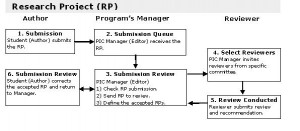
The PIC operational process is divided into the following 5 stages:
1. Research Project → 2. Partial Report → 3. Partial Article →
4. Final Article (FA) → 5. Student Yearbook (SY)
This whole Anhanguera´s PIC management cycle takes a year. After getting through all the process until stage 5, Student Yearbook is available in OJS.
Following is the workflow chart of the student yearbook process (from Dobgenski with permission):
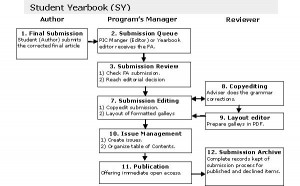
Dobgenski commented AESA uses OJS not only to gather information but also to give students chance to publish their own research. In that way, the integration PIC program with OJS is very practical since it gives chance students to receive feedback of their writing and also produce their own papers. Undergraduate students used to have a role as an information receiver rather than an information producer, but this program helps students publish their own paper as a producer.
AESA also uses OJS for professors training programs (PICD) of which process is:
1. Professor ask for support/budget by application form
2. Campus Director authorizes the application
3. Application’s form is sent to PICD agency
4. PICD agency analyzes and returns final agreement
5. Professor receives agreement confirmation
6. The process is terminated
The session of Dobgenski showed the practical use how OJS facilitates academic and institutional programs. Dobgenski, a manager of AESA, mentioned through her e-mail the management of documents and users associated with an improvement program could become a quite challenging problem. There are a huge number of specific constraints interrelated with scheduling tasks, publishing rules and norms conformance. It is necessary to adopt computer-aid system to keep track of all the information workflow and to guarantee these constraints satisfaction. OJS was very useful tool to allow the manager to setup a minimal-path procedure for electronic publishing. The OJS web system permits create, manage and interact with a huge community around these programs. In 2009, Anhanguera’s PIC received more than 300 project submissions. The presenter emphasized OJS helps run PIC and PICD programs smoothly with a small number of faculty members (4 professors, 1 computer systems analyst, 1 administration assistant).
The Anhanguera’s experience shows that the OJS software permits a considerable spread community formed by students, professors, researchers, managers and academic decision-makers get organized and integrated to improve these programs.
Related Links
Anhanguera Educational S. A.: http://www.unianhanguera.edu.br/anhanguera/
Open Journal System: http://pkp.sfu.ca/?q=ojs
July 14, 2009 7 Comments
Using the Open Journal System to Discuss Human Development and international Cooperation: the Experience of Universitas Forum – The Session Blog
Presenter: Roberta Pellizzoli
Friday, July 10, 2009, 11 pm-12 pm. SFU Harbour Centre. Room 2250
Who is the presenter?
-
Contract professor, Political and Economic Geography of sub-Sahara Africa at University of Bologna, Faculty of Political Science
-
Editorial Administrator, Universitas Forum: International Journal on Human Development and International Cooperation
Session Overview
What is Universitas Forum?
Universitas Forum is peer-reviewed international electronic journal on human development and international cooperation. The aim of Universitas Forum is to offer critical analyses of current approaches to international development cooperation and practice-based research concerning global and local human development such as poverty, health, water shortage, education, inequity, social exclusion, to name a few (see Human Development Resource (HDR net) for more information). The journal is conceived as a tool for encouraging the systematization of local experiences, with the contribution of local journalists and academics. First volume with four issues was published in 2008, and a further three issues are planned for 2009. The journal provides four languages: English, Spanish, French, and Italian. The full text of articles is in the original language, while abstracts are translated. Universitsas Forum is produced by the Universitas programme of the ART initiative. The journal is sponsored by UNOPS.
What is the role of Universitas Forum?
Swartz (2008), the coordinatior of the ART Universitas Programme and of the editorial committee of Universitas Forum, argues that previous development model such as globalization or capitalism createdscompetition and social exclusion rather than cooperation. Moreover, unbalanced distribution of resources and unequal opportunity to contribute between Northern and Southern actors are also barriers on human development. Therefore, an alternative model on human development is urgent.
Universitas Forum was produced under the goal of following:
1. Enhancing resources of local communities and their human development potential
2. Mutual respect and learning, development cooperation of knowledge between North and South
3. A systematization of the experiences of the many actors involved in human development practice
4. Increasing opportunities for accessing and disseminating knowledge of researchers, policy makers or practitioners on human development
However, according to Pellizzoli, the presenter, there are some difficulties the journal is facing:
• Arouse the interest of development practitioners
• Link theoretical knowledge with socially embedded research and practice
• Diversify audience (geographical, institutional, etc)
• Involve local researchers in order to increase the visibility of views from the South
• Increase the number of readers
• Promoting the idea of a public right to knowledge
In addition, she also stated the challenges of Open journal system (Open-Source Publication software of the Universitas Forum for open access). She argued that to improve democratic access to OJS knowledge, English should not be assumed the standard language when dealing with a multilingual journal. Not everyone is a native English speaker, and the fact that English is the default language makes navigating the site more difficult for those who are not native English speakers and not highly computer literate. Although OJS provides several languages (e.g., Chinese, Dutch, Farsi, Japanese, Spanish, etc.) other than English, poor translation is an issue. Moreover, those who do not have high computer skill may be discouraged to use the system.
Therefore, Pellizzoli suggested OJS should be improved, especially in translation, as a multilingual journal. Besides, small grants for researchers from the South should be given to promote systematization of innovative practices and experiences. She also urged that networking with other OJS publications (see here for more open journals) is crucial. Finally, more workshops should be available to create knowledge on human development.
Related Links
Afriche e Orienti: http://www.comune.bologna.it/iperbole/africheorienti/english/rivista.html
Art initiative: http://www.art-initiative.org/
Human Development Resource: http://www.yorku.ca/hdrnet/index.asp
Open journal system: http://pkp.sfu.ca/?q=ojs
Universitas Forum: http://www.universitasforum.org/index.php/ojs/index
UNOPS: http://www.unops.org/english/Pages/default.aspx
Reference
Swartz, S. (2008). Knowledge for human development, Universitas Forum, 1(1). Also available at http://www.universitasforum.org/index.php/ojs/article/view/15/48
July 14, 2009 Comments Off on Using the Open Journal System to Discuss Human Development and international Cooperation: the Experience of Universitas Forum – The Session Blog
An Open-Access, Standards-Supportive Publication that Rapidly Disseminates Concise Genome and Metagenome Reports in Compliance with MIGS/MIMS Standards: the Session Blog
Presenters: Oranmiyan W. Nelson
July 9, 2009 at 2:30 pm
Background
Dr. Nelson is currently completing his post-doctoral work at Michigan State University, in the Department of Microbiology & Molecular Genetics. He is also the production editor of Standards in Genomic Sciences (SIGS), an open-access e-journal of the Genomics Standards Consortium (GCS) established in September 2005.
Session Overview
Genomics and metagenomics describes the study of an organism’s complete genetic data set, with emphasis on sequence mapping. The former is limited to the study of organisms that can be isolated in pure culture, whereas the latter applies to an entire community of microbes in their native environment. Technological advancements have facilitated a data explosion; genomic maps are now being produced at a faster rate than the existing publication infrastructure can accommodate. The result is a loss of data, contextual metadata and annotation. Essentially valuable data is disappearing before it can be interpreted or see the light of publication.

Number of published journal articles per year relating to the complete genome sequences of bacteria and archea
SIGS is a GSC initiative to attempt to bridge this gap, by producing concise peer-reviewed reports that comply with MIGS/MIMS standards, in addition to operation procedures, commentary and review articles. Minimum Information about a (Meta)Genome Sequence (MIGS/MIMS) is a GCS initiative to expand on core reporting standards already established by the International Nucleotide Sequence Database Collaboration (INSDC). MIGS/MIMS is characterized by a standardized checklist that has been published in its entirety in Nature Biotechnology. SIGS will attempt to keep up with data production by offering an accelerated editorial revision workflow, where copy-editing begins almost immediately after initial acceptance.
The e-journal’s goal is to produce 600 publications by June 2011 (approximately 30 per month), by attracting internationally credible authors under a cost-effective model for an open-access journal.
A sample short genomic report was then described, in conjuction with MIGS/MIMS standards. The anatomy of a report included a abstract and introduction (a), genetic sequencing information (b) genome properties (c) and comparisons with previously sequenced genomes (d). Lastly, conclusions and references (e).
References
July 13, 2009 Comments Off on An Open-Access, Standards-Supportive Publication that Rapidly Disseminates Concise Genome and Metagenome Reports in Compliance with MIGS/MIMS Standards: the Session Blog
Moving from Paper Production to Online Open Access with Open Journal Systems: The Session Blog
Presenter: Laura C. Botsford, Assistant to the Editor, Canadian Journal of Sociology, University of Alberta
Time: 4-5 pm, July 9th, 2009
Place: SFU Harbour Centre, Sauder Industries Room 2270
———————————————————————————————
Session Overview
Background
In the early days of the Canadian Journal of Sociology, a great deal of manual work was required to print the journal, from getting galleys to making notes in the margins, to cutting to appropriate size and pasting onto paper sheets, etc. The editors of the journal soon realized that they were susceptible to too many external factors and decided to move to typesetting and a mainframe computer. While this newer technology had its advantages, there were many codes to learn and all that could be seen was the markup language; not the end result. The lack of a preview often created surprises for the editors when the pages were printed. Eventually technology progressed and the journal got some computers with What You See Is What You Get (WYSIWYG) capabilities– but they still had to go through the whole printing process. Dr. Kevin D. Haggerty took over as editor in 2007 and within a few months, decided to go electronic and open access with the journal. While everyone involved had many questions and qualms, they ultimately ‘took the plunge.’
Related Information Re: Printing Processes
Click here for a printing press demonstration on Youtube
A more recent version of the printing press:
(source)
Using the Open Journal System (OJS)
Moving to electronic publishing has reduced many of the traditional problems involved with the printing process and OJS has features that are very helpful, such as its functionality for the second review– the system automatically generates a list of reviewers and filters out those who have already declined in the first review.
However, OJS still poses many problems for users, so patience and technical support is absolutely critical.
Session Questions
Comment: There are currently seventeen journals running on the University of Alberta website, but the Canadian Journal of Sociology has been the most conversive, and questions have really pushed the development of OJS forward.
Question: What was the driving force to move to online and open access? We were becoming aware of the new generation of scholars coming up, and they are expecting to see their info on the internet. Also, printing and mailing is becoming increasingly expensive.
Question: How many copies were being printed prior to moving to electronic form? Answer: 1000
Question: How has converting from print to open access impacted the finances of the journal? Answer: It was a subscription journal, but the journal has been anomalous. We had some money in the bank, and received money from aggregators who have continued to contribute. One of the reasons for moving to open access was that subscriptions were dwindling– libraries were declining because they were lacking space and funding.
Question: Any plans to digitize back files? Answer: Yes. We haven’t tried it yet, but are definitely planning to.
Question: What is your business model? How much does it really cost to run the journal? Revenue stream? etc. Answer: Revenue stream usually from the Social Sciences and Humanities Research Council of Canada (SSHRC) and aggregators, but we also had money in bank that was invested. We also benefit from non-monetary things that the university provides, such as office space, release time from teaching for Dr. Haggerty, etc.
References
Taking the plunge Haggerty, K.D. (2008). “Taking the plunge: open access at the Canadian Journal of Sociology” Information Research, 13(1) paper 338. [Available at http://InformationR.net/ir/13-1/paper338.html]
Related Links
July 13, 2009 Comments Off on Moving from Paper Production to Online Open Access with Open Journal Systems: The Session Blog
Publishing Freedom of Information: the Open Government Records Plug-In for OJS: The Session Blog
Presenter: Mark Weiler, PhD Candidate, Simon Fraser University
Background
Freedom of information (FOI) legislation was enacted in Canada in 1983. This legislation, in existence in various forms throughout the world, allows individuals to request access to government-held information. In Canada, there is no formal database to allow interested parties to search for previously submitted FOI requests, or for the documents released as a result of these requests.
Session Overview – Session Abstract
Mark Weiler is interested in developing technologies that allow students and other academics to carry out historical research. Recently, he became interested in the use of Open Journal Systems (OJS) and its capacity to make government-held knowledge more accessible to academics as well as to the general public. This interest is in keeping with the aims and goals of the Open Access movement, namely, to make accessible information held by the government through Freedom of Information legislation.
Open Government Records (OGR), initially designed as a plug-in for OJS, helps journals to submit, track and publish FOI requests and the resulting correspondence and documentation that follows these initial requests.
The OGR website currently offers access to several FOI repositories touching on a number of areas of interest, including public servant curriculum and scholarships/grants. What the website allows, above and beyond what a traditional print-published compilation of the FOI requests would, is the ability to offer access as the documents are obtained.
Commentary and Questions
The ensuing discussion highlighted a number of the potential uses of the OGR technology. Notably, journalism schools were felt to be likely beneficiaries. This type of repository could help inform work on government policy, public servant salaries, etc… There was concern, however, that journalists may be reluctant to submit FOI requests to a database for fear of being “scooped”.
Another area of discussion concerned to potential use of this type of technology to help users submit information requests to journals in order to obtain more information about their corporate structure and partnerships.
Related links
Below are a series of links to websites and societies dedicated to civic action and freedom of information;
Open Government Records – The OGR website, with its FOI repositories.
Visible Government – A Canadian NGO website dedicated to increasing government transparency.
What Do They Know? – Database of UK FOI requests.
MySociety – UK civic action website.
References
Weiler, M. (2009). Publishing freedom of information: the open government records plugin for ojs. PKP Scholarly Publishing Conference 2009. Retrieved 2009-07-08, from http://pkp.sfu.ca/ocs/pkp/index.php/pkp2009/pkp2009/paper/view/131
July 12, 2009 Comments Off on Publishing Freedom of Information: the Open Government Records Plug-In for OJS: The Session Blog
Open Journal Systems (OJS) software as used by African Journals Online (AJOL) – The Session Blog
July 9, 2009 at 10:30 a.m. SFU Harbour Centre (remote session). Rm. 7000
Susan Murray (Source)
Background
Ms. Susan Murray is a proactive individual working with the African Journals Online (AJOL), a non-profit organization, as the executive director for over two years. Her she academic background is on development economics and she is focused on opening access to information in developing countries such as Africa.
Session Overview
Ms. Murray’s session is a journey from the 1990s to present day focusing on the progression of access to African Journals Online (AJOL) (Session Abstract). She begins with an overview of the journal, followed by the users and stakeholders involved, which she ties in to a comparison of the old and new systems along with the future outlook for AJOL, and finally she concludes the presentation with a business plan and parting remarks.
(1) Overview of AJOL
Ms. Susan Murray started the presentation with the following quote from Mamphela Ramphele :
“There is no way we can succeed in the eradication of poverty if the developing world is not part of knowledge creation, its dissemination and utilization to promote innovation. Higher education is a critical factor in making this possible and must be part of any development strategy.”
– Mamphela Ramphele (2000)
Ms. Murray goes on to explain the importance of higher education and policies governing such institutes. She indicates that there is a long way to go in terms of sharing and transferring knowledge to the developing worlds, however it must be done and there is harm in not doing so as innovation cannot advance in these developing countries. In Africa the process of dissemination has already begun with AJOL hoping to increase its visibility and accessibility of open journal sources. Currently, AJOL has 350 titles with over 40000 articles (and free metadata) which are a combination of open-access (OA) and subscription based titles that cover majority of the academic spectrum. Ms. Murray pointed out that some of the titles are not found online anywhere else but on AJOL! This shows the exclusivity of some of the titles that are secured by AJOL. In order to join AJOL, Ms. Murray listed the following criteria which must be adhered to – this mostly encourages more of the ‘fringe’ journals to upload their documents for increased visibility:
- Must be original research
- Needs to be peer-reviewed
- All content must be given to AJOL
- Permission must be granted to AJOL
- Content must be published in the African continent
(2) The Stakeholders
It is fascinating to know that as of today, Ms. Murray highlighted the 26 African countries with journals on AJOL (See Figure 1a). Figure 1b is a ‘Google Maps mashup’ which highlights the actual journals (with corresponding links) in a particular country. Ms. Murray exclaimed this is an impressive display along with the number of visits by other continents as illustrated in Figure 2. Africa had the highest percentage of visitors at 32% of the total population who accessed the site, while North America, Asia, and Europe had 23%, 21%, and 20% respectively.
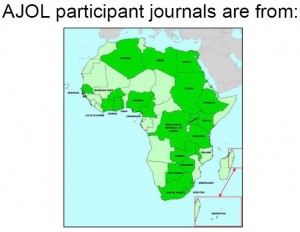
Figure 1a: Distribution of Journals in Africa (used with permission from Ms. Murray)
View Map of Africa in a larger map
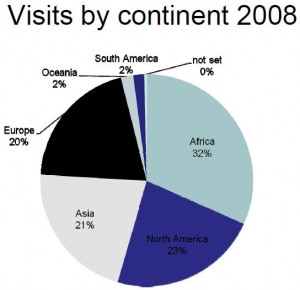
Figure 2: Visits by continent (used with permission from Ms. S. Murray)
(3) Comparison of old and new systems
After the overview and elaboration of the users and stakeholders of AJOL, Ms. Murray went into the details of the AJOL on OJS 2.2.2. She expressed the benefits of such a partnership with PKP led to better upgrading of the system. She found that more advanced versions could also be complied and were easier to upload which allowed for more capabilities in the platform that were not possible before. Figure 3 shows flowchart of the software and resources used ending with final product of the Open Journal Systems coded through the PHP scripting language using MySQL as the database management tool in the APACHE web browser run from the Linux operating system.
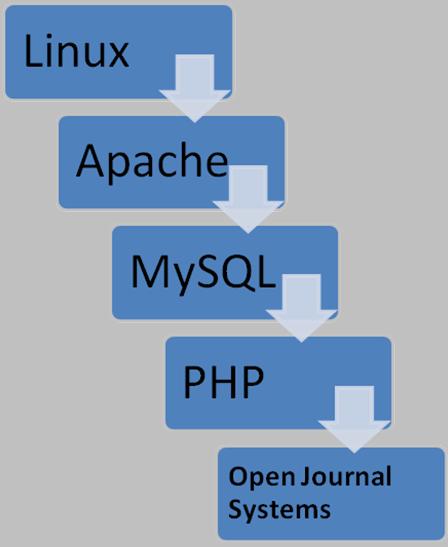
Figure 3: Software and Resources (created by Pam Gill)
A comparison of the new and old system is shown in Figure 4. The new approach is useful for all parties involved and is an excellent search tool with a new look and feel. Currently, as of July 2009, journals now manage their own AJOL pages in terms of the workflow management. In the future, Ms. Murray envisions that journals will be able to host their own versions of OJS on the PKP harvester which acts as a metadata aggregator. The newer versions will include a statistics package and offline plug-ins when connectivity is interrupted. The offline plug-in option will be crucial for users living in remote areas. Eventually, Ms. Murray envisions all journals being independent and managing their own pages.
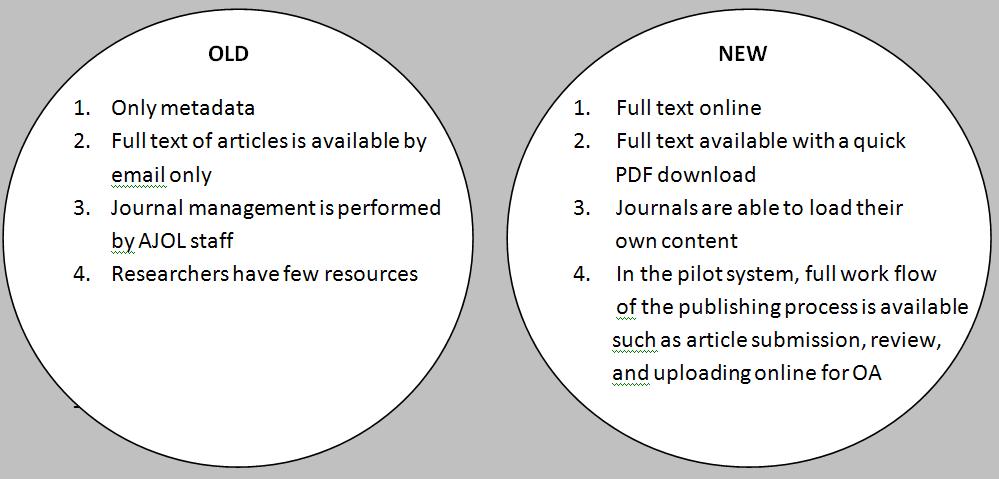
Figure 4: Comparison Chart of Old and New Systems (created by Pam Gill)
To conclude her presentation, Ms. Murray placed great emphasis on the need for the flow of global information from the North to the South (Evans and Reimer, 2009). She stressed the implementation of a new business plan that would allow journals to consider OA as a more viable possibility via AJOL/PKP. The full OJS functionality on AJOL has already made a huge difference as discussed earlier as open source software (OSS) has matured considerably. To summarize Ms. Murray ended her presentation one two key points to promote and continue the dissemination of literature in developing countries. First she brought forth the importance of carefully selecting the best tool that will take into account the needs of the users. Next, she advised to carefully align yourself with partners that you trust and who will support your initiatives for the right reasons. The following quote from Ms. Susan Murray herself summarizes these points:
“Relationships and communication are still the drivers of success, the technological tools are just the vehicle.”
– Susan Murray (2009)
This quote from Ms. Murray is used to illustrate that the technology can help propel the dissemination process in varying capacities. Technology depends on the specifications and limitations of the hardware and software. Yet, at the end of the day, relationships with others are the most important in terms of communicating, working collaboratively sharing ideas, which will ultimately lead to the success (or failure) of your goals and aspirations.
Questions from the audience asked at Ms. Murray’s session:
Question: Is AJOL published in other languages (referring to Figure 1 of African map from Susan’s PowerPoint slide)? Does AJOL have plans to bring more non-English journals to the portal?
Answer: Yes, we are hoping to introduce this to Francophone countries by starting the process of translating to French. So there will be an English/French option. We have a few journals published in Portuguese, Arabic. If we have a journal that is online (and space is NOT a problem) then we can publish in a local, indigenous and international language. Then at the same time research can be read by the local community and broadly by the rest of the world. This will increase readership and the journal will have met the needs to satisfy the best of both worlds.
Related Links
Conference attended by Susan Murray
Software/Sites
- African Journals Online
- OJS 2.2.2 Download
- PKP Open Archives Harvester: free metadata indexing system
References
Evans, J.A, & Reimer, J. (2009). Open Access and Global Participation in Science . Science. 323, 1025
Murray, S. (2009). Open journal systems (OJS) software as used by African journals online (AJOL). PKP Scholarly Publishing Conference 2009. Retrieved 2009-07-09, from http://pkp.sfu.ca/ocs/pkp/index.php/pkp2009/pkp2009/paper/view/216
July 11, 2009 1 Comment
Maximizing the Reach of a Graduate Research Journal Through Open Source Tools and Social Media: The Session Blog
Presenter: Rajendra Bose
July 10th, 2009 at 3:30 p.m.
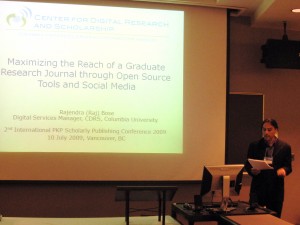
(used with permission from Raj Bose)
Background Info
Cultural Formations is an online journal (due to launch next month) that is open-access and peer-reviewed. The Center for Digital Research and Scholarship (CDRS) collaborated with Columbia University’s Teachers College to form Students for a Cultural Studies Initiative (SCSI). This project has grown to become more than just an online journal, using the concepts of Web 2.0 and Social Media as well as a research repository, Academic Commons.
As quoted on the Cultural Formations website, the journal-plus project has “…three integrated elements: an online journal of peer-reviewed articles, a blog for discussion of published articles and works in progress, and a wiki to serve as a “Wikipedia” of cultural studies and education.”
Session Overview
Graduate students at Columbia University and the Teachers College joined forces to form SCSI. Over the past year, they have worked hard to start a “journal-plus” – an online space that looks at cultural formations including youth culture, media, music, art, film and ethnicity, etc. Their goal is to not only publish research but to be accessible to the entire community, not just academic scholars. Along the way they were faced with significant challenges (examples include web design, technical problems with layout of the vastly different programs and challenges from having multiple partners with decision-making authority). They are however on schedule to launch their site next month. (Please stay tuned to this blog for the launch announcement!)
Services they hope to provide
- Publications – e.g. online books, journals
- Conferences
- Academic Commons
- Wikischolars
An example of what their website will look like:

(Used with permission from Raj Bose)
The goals of the Cultural Formations site are three-fold:
- authority of a journal
- immediacy of a blog
- what’s new and emerging in wiki format
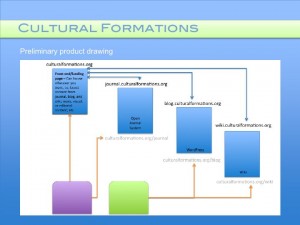
(Used with permission from Raj Bose)
The site is scheduled to launch in August 2009 at Culturalformations.columbia.edu (URL may change prior to launch).
Questions from the audience
1. Impressive. Will you open this up to the public as open source?
Yes, we are using all open access materials. The idea is to share it with the rest of the community, Users may have to connect with us to get a user profile as it may be too expensive to allow it open to all users at once. There likely will be a basic free level, and we may charge for some of the more advanced functions. We feel the site will have longevity with the article content/repository.
2. Is there a similar movement in other universities?
Yes, but the idea right now is to work with university presses and authors right here to get the right agreements.
3. Is there going to be any co-ordination with other groups?
Already there are 50-100 student journals with OJS [Open Journal System]. You especially want this system for longevity when a student group starts to fade out, this will help. The university hosting this site will help keep those groups up and running.
4. What about groups with other levels of education and how this may be used?
This idea is not a typical journal, but the idea to connect a blog and a wiki so that other members of community can join or help is amazing and very inclusive. Because of this, there will only be a light peer review. They partners want to keep this as open as possible.
Related Links
Center for Digital Research and Scholarship (CDRS)

Open Archives Initiative Object Reuse and Exchange (OAI-ORE)
July 10, 2009 Comments Off on Maximizing the Reach of a Graduate Research Journal Through Open Source Tools and Social Media: The Session Blog
Creating an Open Access Journal; A Medical Students’ Prospective: The Session Blog
Presenters: Steven Andrew Plato II and Andrew James Wyman (remotely), David Solomon in-house
July 10th, 2009 at 3:30 p.m.
Background info
Steve Plato and Andrew Wyman are third-year medical students from Michigan State University who saw a need in the literature for a dedicated place for medical students to publish their work and founded The Medical Student Research Journal (MSRJ) in 2007. They are due to publish the first issue this fall.
Session Overview
The session got off to a rough start with a few technical difficulties (due to new too-loud speakers in the meeting room at Simon Fraser University). The students gave the presentation from their editorial room in Michigan via Adobe Connect Pro. They use this to connect with the many geographically diverse authors/editors/faculty associated with their journal. The image, Powerpoint and voice are very clear. This is an exciting software tool for all distributed learning models.
The students went on to explain that they started the journal to fill a gap. Most students have extensively researched their chosen field of specialty throughout medical school, but often do not know how or where to publish their work. Whereas 60-100% (depending on specialty) of medical students matching to their first-choice residency stated they had extensive research in their field, the proportion of those that had published was as low as 35% for some specialties. MSRJ is peer-reviewed, authored and edited entirely by medical students which they hope will be the go to journal for medical students to publish that work.
This project was started at the Michigan State University but the creators hope to reach medical students throughout the US as well as internationally. THE MSRJ uses Open Journal Systems (OJS) and Creative Commons licencing to ensure communication and availability of publication to all medical students. This project is similar to a one started a few years earlier by the same institution (MSU) in a graduate biotechnology course (see session blog from this conference) however on a much quicker timeline, around 28 days!
OJS has been very helpful for the med students as it helps to facilitate their multi-location system, has low overhead and allows them rolling publication with minimal delays. They also like the management tools that help to guide novice editors (reminders/checklists) to make the process simple. OJS also tends to being in a larger readership.
Faculty
Faculty assure quality peer-review. Students are trained by faculty in critical appraisal, principles of scientific writing and academic integrity. They are also able to review a mock article and can compare their reviews to similar good and poor examples to learn to become a better reviewer. Faculty also provide guidance on sustainability and establish good practice in mentees (more hands-on and one-on-one time with people who know the literature the best). The students all go through an online training module, from the Annals of Emergency Medicine, prior to starting as well.
Usually one faculty will mentor 3-4 students per article. This helps less experienced reviewers in specific fields. They also provide feedback and guidance on where a review may be lacking. Students can then re-review and submit, then the editor decides to accept, accept with revisions or decline the article.
Sustainability plans?
Many other journals before this have struggled with longevity. MSRJ have instituted a student replacement policy (juniors that will take over when the current editors are done) and training sessions for editors which serve as quality control. In addition a letter from the Dean will be placed into the student file for encouragement to participate and to continue the job. Faculty are also rewarded by recognition in published material as well as a formal letter to their respective Departmental Chair. An annual report with statistics on publications is also planned for accountability
Finances?
The students plan for this journal to be a free or very low cost venture. All labour is by students or faculty. There is a minimal cost for the website host, however their major cost is copyediting, which they hope will be eliminated by using university resources. XML generation is also a marginal expense as is website development.
Benefits
The students feel the benefits are quite clear. They build experience in scientific writing and editing as well as get a head start on publications for their career. It is also strongly beneficial for those students doing research outside academic centres such as rural and distributed sites.
Since Open Journal System (OJS) has become a forerunner in educational resources, many other institutions have been able to start similar projects, with one just ready to launch this fall here at my home institution, UBC. The UBC Medical Journal will provide medical students with a forum to publish their research work that previously had no definitive place for publication.
Questions from the audience
1. I understand medical school is an intense experience. Do you have to sacrifice other parts of the educational experience to participate?
While it is true it is intense, but one thing about medical school is it does allow you to do things outside of school. Most students are involved in extracurricular activities already and 60-100% already involved in research. There will be some sacrifice, but usually that would be less time for research projects (i.e. one instead of two). The time intensity of the reviewer part of the job is not significant. Students only review one article at a time. There is a base here already, but it does take away time, hopefully that time is well spent.
2. Are the training materials you used publically available?
Yes they are online in the Annals of Emergency Medicine Journal. They have a great online flash based training process that we used.
3. Do you plan on only accepting articles from MSU or do you plan to open the journal up to other universities?
This journal will be open to med student/residents around the world once it is started. MSU is unique in their distributed plan in the states. Right now, you can submit from anywhere, but we hope to expand reviewers across the country.
Related links
The Medical Student Research Journal
Andrew@msrj.chm.msu.edu
Steven@msrj.chm.msu.edu
dsolomon@msu.edu

July 10, 2009 Comments Off on Creating an Open Access Journal; A Medical Students’ Prospective: The Session Blog
Who knows what, when? Current and desired capacities for online journal statistics gathering and dissemination: The Session Blog
Friday, July 10, 2009 @ 9:30
SFU Harbour Centre (Earl & Jennie Lohn Rm 7000)
Presenters:
Andrea Kosavic (Digital Initiatives Librarian at York University)
James MacGregor (PKP Associate)
Session Overview
James MacGregor and Andrea Kosavic outline their efforts to provide a suitable recommendation to Synergies Canada on what they should provide in terms of statistics and to whom based on a survey of current and desired practices in online journals. Kosavic explained that her interest in participating in this study stemmed from having multiple statistics requests at once at York and being overwhelmed by the lack of a streamlined method of reporting this information.
Commentary
In trying to establish a recommendation to Synergies Canada regarding what statistics should be collected and shared, Kosavic and MacGregor proceeded to:
1) establish what is currently supported or lacking.
2) survey journals and repository holders to see what they actually need.
3) draw up recommendations.
Using Open Journal Systems (“OJS”) and Erudit Consortium as targets for recommendations, the following was initially noted:
– they do not share common statistics collection;
– both can capture the number of items viewed per month (with the help of external software);
– other statistics are difficult to capture; and
– both have reporting functionalities.
Key questions were asked of respondents in order to frame findings with 75% of respondents claimed that their current statistics collecting solution was not satisfactory.
Key findings include:
– 51% of OJS users utilize the built in reporting tool.
– 30% of respondents use 2 or more tools.
– Identifiying the number of “unique visitors” was deemed the most important statistic.
– Web pages accessed and page clicks were identified as the most collected statistics.
– RSS feed information was identified as the least collected statistic.
– Statistic collection ranged from monthly to quarterly to yearly with no significant majority.
In regards to the sharing of statistical information, the survey indicates that a significant gap exists between who journals are currently sharing statistics with and who they anticipate sharing statistics with.
Kosavic and MacGregor learned that there appeared to be no ideal statistical management system. The speakers were asked by someone in the audience about whether or not it will be possible to tell whether or not an end user is actually reading an article and if so, how much and what is being cited (if anything). MacGregor explained that this statistic was not collected and that there is currently no way to track this information; another member of the audience compared it to trying to be able to track how much of a book a library patron read. Ultimately this would be ideal to be able to track but unrealistic in the near future. It was also noted that referrer statistics were not included in the survey, that is, information related to how viewers came to find a journal site/article.
Recommendations for statistical gathering and disseminating:
– should standardize on 3rd party reporting across all nodes;
– use SUSHI protocol to collect statistics;
– implement COUNTER protocol to collect statistics;
– extend COUNTER to cover other Synergies items.
At different points in the presentation, MacGregor showed a different visual representation based on his gradually refining understanding of current and desired capabilities and the flow of statistical dissemination. This was helpful in demonstrating that initially there were many complicated methods of statistic collection and possibilities but eventually, with greater understanding, MacGregor was able to illustrate an easy to understanding model for statistic management.
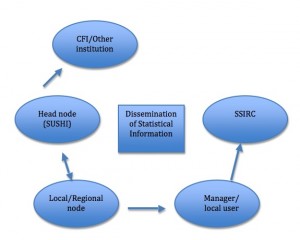
(Figure 1.0 – Final visual representation representing a steamlined view of the dissemination of statistical information)
Stakeholders, statistics desired and relevant protocols have been identified and the final report is in the process of being completed.
Related Links
July 10, 2009 Comments Off on Who knows what, when? Current and desired capacities for online journal statistics gathering and dissemination: The Session Blog
Do Not Press Print: What Can We Do to Keep the Reader Engaged in Online Use of Journals?: The Session Blog
When: Friday, July 10, 2009 3:30pm – 4:30pm
Room: Main Concourse – Fletcher Challenge Room 1900
Presenters: Rick Kopak, Chia-Ning Chiang
Rick Kopak is an Assistant Professor at the School of Library, Archival, and Information Studies, UBC. Chia-Ning Chiang is a PhD Candidate at the School of Library, Archival, and Information Studies, UBC.

Chia-Ning Chiang and Rick Kopak (Source: Photo taken by Helen Szeto)
Session Overview:
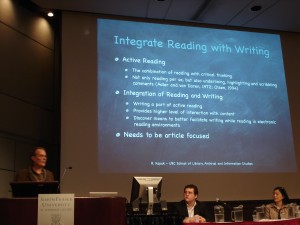
Rick Kopak presentation (Source: Photo taken by Helen Szeto)
The purpose behind this session is to look at ways to engage journal readers through the journal’s interface. Rick Kopak and Chia-Ning Chiang presented a series of reading tools in the Open Journal System (OJS) that will critically engage readers as they read through the articles. They want to provide an environment that enables an active reading process where they are thinking about the information as they read.
The reading tools will help the reader focus on the article and interact with it. Also, the reader can bring in other related information on the topic; making connections in the process. Kopak gives examples of reading tools found in other models: highwire press, PubMed and PIRA (Personal Information Retrieval Assistant).
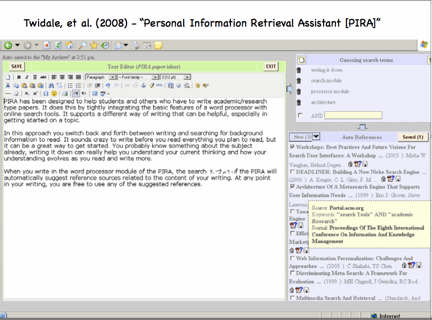
PIRA screen capture (Source: slide courtesy of Rick Kopak)
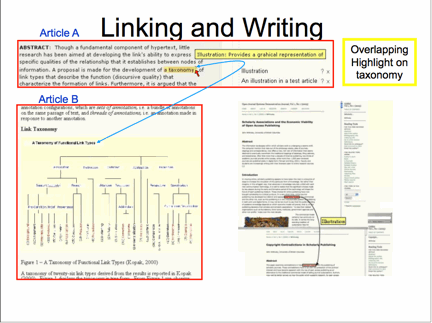
Linking and Writing (Source: slide courtesy of Rick Kopak)
For the prototype of reading tools being developed for OJS, there are two components: annotation and linking. Writing annotations allow the reader to capture their thinking process as they read. They also provide a visual search of ideas on the sides of the article. In the prototype, readers can highlight text and space is allotted on the side for notes. Linking and link typing are extensions of annotation. Readers can link to another piece that elaborates on the article topic. The idea behind linking is to capture relationships between different journals and make connections.
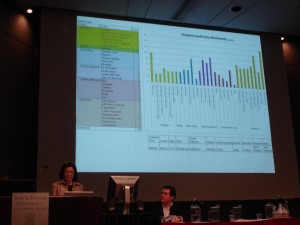
Chin-Ning Chiang Presentation (Source: Photo taken by Helen Szeto)
During Chin-Ning’s part of the presentation, she reviews a bar graph chart that compares the features of reading tools from 2006 to 2009. There are social components to article reading as well. Reader comments can be found at the bottom of the page. Chiang argues that comments at the bottom of the page are ineffective because people rarely scroll down to the bottom. Also, readers lose context when they scroll away from the text.

reading tools chart (Source: slide courtesy of Rick Kopak)
There are 5 parts that Chiang and Kopak would like to include in their production version of OJS reading tools: highlighting, note making, workspace, public views, and linking. Chiang and Kopak would like the reader to have more control over highlighting, including the choice of colours and tone densities. For note making, readers would be able to toggle the note function on and off, and have the ability to fold long notes. A workspace will also be created for people to start composing and clipping notes and text to the workspace. In the public view mode, individual markings can be shared which promotes social interaction among academics. It allows readers to view the multiple commentaries in an article. Finally, the linking function will give the user more control. Some of these abilities include clicking links off and on, creating hyper links and being able to tag annotations and highlighted text.
(Source: powerpoint presentation courtesy of Rick Kopak)
Session Analysis:
Chiang and Kopak were clear on their intentions on creating reading tools for OJS. They referred to existing reading tools to show improvements they wanted to make. The screenshots of the various interfaces were helpful visuals to understand the different tool functions. The rationale behind each component and their beneficial functions were clearly explained to persuade the audience that the reading tools will enrich the reading process greatly in OJS.
Session Questions and Answers:
A gentleman in the audience posed the following questions: What about the editorial view? Can we apply these tools there?
I couldn’t hear the reply clearly, but Kopak sent me an email reply to the questions asked.
Kopak’s reply: “The gentleman’s question concerned whether we ever thought of using the Annotation and Linking Reading Tools for the Editorial view in OJS in addition to the Reader View. I said yes, we had considered it, and it might be a feature in the Editorial View at some point in the future. But, at the moment, we were focusing on the readers of OJS journal articles. In the Editorial View, editors and reviewers could comment on journal articles directly using the Annotation Tool specifically, and editors could give editorial instructions as well.”
Related Links:
- School of Library, Archival and Information Studies, Univers
- PKP 2007 – A Multi-dimensional Approach to the Study of Online Annotation (presented by Rick Kopak & Chia-Ning Chiang)
- OJS Help – Reading Tools
July 10, 2009 Comments Off on Do Not Press Print: What Can We Do to Keep the Reader Engaged in Online Use of Journals?: The Session Blog

